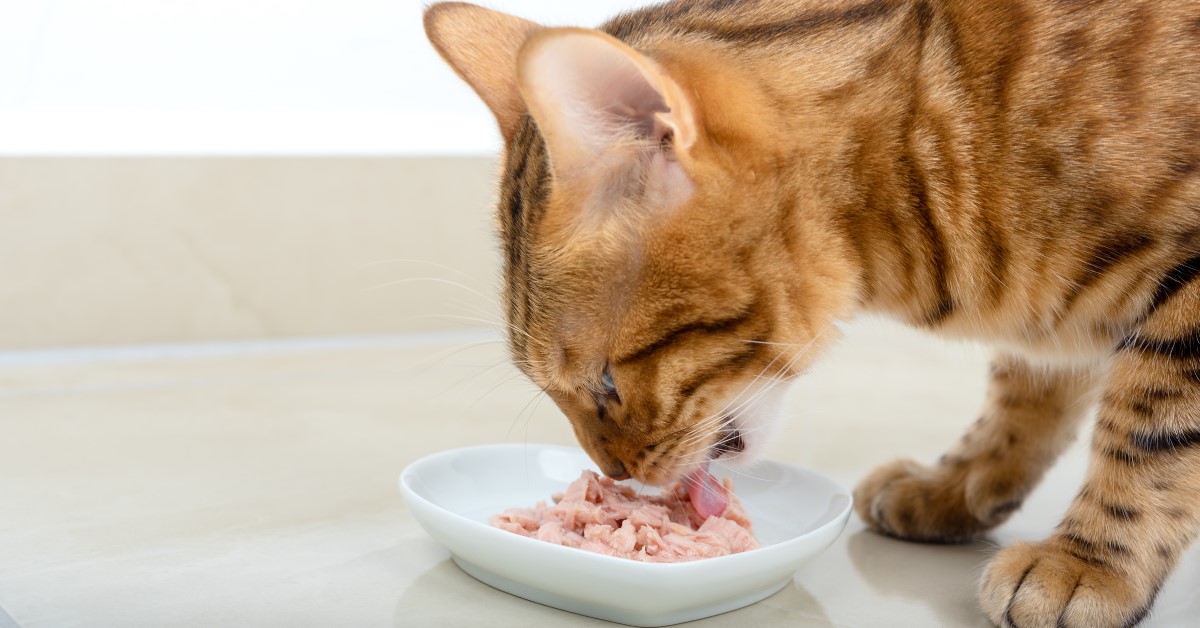Cats & Tuna – Is It Safe to Eat?
Canned tuna can be a tasty treat for cats but should be served in moderation.

Cats are obligate carnivores, meaning they require meat to survive. While there is no single diet that is appropriate for all felines, most do well with an animal-based protein diet that is high in moisture and low in carbohydrates. Rich in unsaturated fats like omega fatty acids, tuna is a tasty treat many cats enjoy. However, tuna is not nutritionally balanced and should not make up the bulk of your cat’s daily diet. Instead, it should be fed to your pet in moderation.
Is Tuna Healthy for Cats?
Tuna is typically purchased in cans and comes packed in oil or water, affecting its nutritional value. Due to the oil content, tuna packed in oil tends to be higher in fat and calories than tuna packed in water.
While the nutritional content of tuna can range from brand to brand, tuna generally does not contain any fiber, sugar, or carbohydrates. It is high in omega-3 fatty acids but low in overall fat, containing just two grams per can of “light” tuna.
Tuna is high in protein, with an average can providing 42 grams of complete protein, along with all essential amino acids. You’ll also discover that tuna contains many vitamins and minerals, such as calcium, zinc, potassium, phosphorus, and B vitamins.
Cats are often attracted to tuna due to its alluring aroma and delicious taste. In moderation, tuna can be a safe and healthy treat when given to cats. However, there are some concerns about the safety of tuna.
Can Cats Get Mercury Poisoning?
One of the biggest concerns regarding tuna fish and cats relates to mercury poisoning. Mercury poisoning is toxicity from mercury consumption or exposure. Modern cats are at risk of developing organic mercury poisoning when fed large amounts of tuna or cat food containing tuna.
Toxic effects can develop after prolonged ingestion of seafood due to a buildup of mercury in the body. Some of the most common symptoms of mercury poisoning in cats are ataxia (wobbly gait), abnormal behavior, tremors or seizures, loss of coordination, paralysis, depression of the central nervous system, nystagmus (involuntary eye movements), hypermetria (involuntary body movement), vision loss or blindness, and in severe cases, death.
Until the risks of consuming tuna are better known, limiting your cat’s tuna consumption to the occasional serving of chunk light tuna is essential. Avoid albacore tuna, which is derived from a larger tuna species that contain mercury levels that are nearly three times higher than other tunas.
How Can Tuna Affect Your Cat?
A well-balanced diet for a cat includes essential fatty acids, protein, vitamins, minerals, and other proteins. When cats eat too little or too much of certain foods or nutrients, health problems can develop.
Tuna is not considered a nutritionally-balanced food, meaning it shouldn’t be a source of meals for your pet. Too much tuna in your cat’s diet can also lead to weight gain, especially if you have an indoor cat that is not very active. The World Small Animal Veterinary Association recommends a maximum of 290 calories per day for a cat weighing 11 pounds.
Not all cats can digest tuna, and some cats may even be allergic. Fish is considered a leading food allergen in cats and can lead to symptoms like hair loss, itching, red bumps, and swollen skin. Cats with food allergies may also experience gas, loss of appetite, diarrhea, and vomiting.
Tuna is highly appealing to most cats, and if fed regularly, they might avoid eating their regular food to get more tuna. It is important not to overindulge your cat as this can lead to a picky eater and feeding difficulties.
How Should I Feed My Cat Tuna?
Before feeding your cat tuna for the first time, consult with your veterinarian. Your vet can guide you regarding the appropriate serving size for your cat, how to prepare the tuna, and how often to give tuna to your pet.
Start by giving your cat just a small amount of tuna to see if there are any adverse reactions. If your cat shows signs of an allergic reaction or illness, do not give your cat any more tuna and contact your vet.
Remember that tuna should only be an occasional treat for your cat. It is best when tuna is mixed with your cat’s regular food. An entire can of tuna is too much for a single serving. Just one teaspoon of tuna given to your cat a few times a week is sufficient. Opt for tuna in water that contains no additives or chemicals.
There has been much controversy over feeding cats raw tuna. Some experts claim that adding fresh food like raw tuna to a pet’s diet can introduce certain risks, such as bacterial infections. For this reason, many vets do not recommend feeding cats fresh fish.
Some types of fresh fish also contain an enzyme that destroys thiamine, leading to convulsions, neurological problems, and even death. Cooked tuna is the safest method as heating the food kills the bacteria.
Proper Nutrition for Optimal Cat Health
Tuna offers a host of health benefits to cats when consumed in moderation. It can help boost immunity, lower blood pressure, reduce inflammation, and help cats grow and thrive. When part of a healthy, balanced diet, a spoonful of tuna can make your cat happy without sacrificing his health.
Ready to start saving money on pet wellness care?
Then take a look at Mint Wellness, the pet wellness plan that provides fast reimbursement on routine pet care. Save on vaccinations, wellness exams, preventatives, dental, and more!
Learn More


